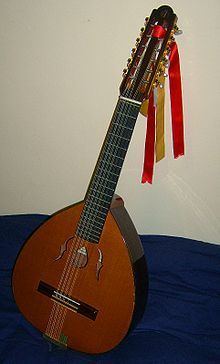 | ||
Fantas a en la menor david kellner 1749 la d barroco
Laúd (Spanish: "lute") is a plectrum-plucked chordophone from Spain, played also in diaspora countries such as Cuba and the Philippines.
Contents
- Fantas a en la menor david kellner 1749 la d barroco
- Instrument 16 tenor lute la d tenor uriel rodr guez s
- Tuning
- Cuban lad
- References
It belongs to the cittern family of instruments, with six double courses in unison (i.e. twelve strings in pairs), similar to the bandurria, but with a longer neck.
Traditionally it is used by folk string musical groups, such as the Filipino rondalla string ensemble, together with the guitar and the bandurria. Like the bandurria, it is tuned in fourths, but its range is one octave lower.
Instrument 16 tenor lute la d tenor uriel rodr guez s
Tuning
The Filipino version has (from bass to treble) one single course, two double courses and three triple courses (i.e. fourteen strings), and is tuned a step lower, F# B E A D G.
The Cuban tuning is: D, A, E, B, F#, C# (or D).
Cuban laúd
There is also a Cuban variety of laúd (such as played by Barbarito Torres of the Buena Vista Social Club). It has the same appearance and use as the Spanish version, six sets of doubled strings, but a shorter scale length and the tuning is different. Sometimes the Cuban variety has a different body shape, with two points instead of the lute-style or wavy shapes used for the traditional Spanish variety.
